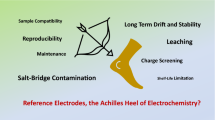Abstract
The direct-current (Faradic) resistance is important because it is the highest impedance that an electrode-electrolyte interface can attain. In this study, the Faradic resistance (Rf) of identical pairs of 0.5 cm2 electrodes of bare and chlorided silver, tin and chlorided tin, nickel–silver, copper, and carbon was measured in contact with 0.9% saline at room temperature. It was found that for positive and negative current flow, the data fit the expression Rf=Rf0e--α i (with a high coefficient of determination), where Rf0 is the zero-current Faradic resistance and α is a constant that describes the manner in which Rf decreases with increasing current (i). It was found that chlorided silver exhibited the lowest Rf0 removing the chloride deposit increased Rf0 by more than sixfold. Likewise, chloriding tin reduced Rf0 by a factor of about 2. Electrolytically cleaning an electrode reduced Rf0. The highest value for Rf0 was for carbon. This paper concludes with a summary of the data for Rf0 scaled to 1 cm2 electrode area for the electrode materials measured in the present study and data from the published literature. © 2001 Biomedical Engineering Society.
PAC01: 8780-y, 8437+q, 8768+z, 8719Nn
Similar content being viewed by others
REFERENCES
AAMI-ANSI. Disposable ECG Electrodes EC12, 1991. Association for the Advancement of Medical Instrumentation (AAMI 3330 Washington Blvd., Arlington, VA 22201–4598
Artz, W. Silicone-rubber electrodes for long-term patient monitoring. Biomed. Eng. 5:300–330, 1970.
d'Arsonval, A. Electrodes impolarisable homogenes. Comptes Rendus 38:288–289, 1886.
Faraday, M. Experimental researches in electricity. 7th series. Philos. Trans. R. Soc. London 124:77–12, 1834.
Ferrari, R. K. X-ray transmissive transcutaneous stimulating electrode. US Patent No. 5,571,165 (5 Nov. 1996).
Geddes, L. A., L. E. Baker, and A. G. Moore. Optimum electrolytic chloriding of silver electrodes. Med. Biol. Eng. Comput. 7:49–56, 1969.
Geddes, L. A. Evolution of circuit models for the electrode-electrolyte interface. Ann. Biomed. Eng. 25:1–14, 1997.
Geddes, L. A., and L. E. Baker. Principles of Applied Bio-medical Instrumentation. 2nd ed. New York: Wiley, 1975.
Getzel, W. A., and J. G. Webster. Minimizing silver-silver chloride electrode impedance. IEEE Trans. Biomed. Eng. 23:87–88, 1976.
Grubbs, D. S. New technique for reducing the impedance of silver silver-chloride electrodes. Med. Biol. Eng. Comput. 21:232–234, 1983.
Heath, R. L. Tin-stannous chloride electrode element. US Patent No. 4,852,585 (1 Aug. 1989).
James, W. B., and H. B. Williams. The electrocardiogram in clinical medicine. Am. J. Med. 140:408–421, 1910.
Jenkner, F. A new electrode material for multipurpose bio-medical application. EEG Clin. Neurophysiol. 23:570–571, 1967.
Kado, R. T., W. R. Adey, and J. R. Zweizig. Electrode systems for recording EEG from physically active subjects. Proc. Ann. Conf. Eng. Med. Biol. 6:1–129, 1964.
Marmont, G. Studies on the axon membrane. J. Cell. Comp. Physiol. 34:351–381, 1949.
Mayer, S., L. A. Geddes, J. D. Bourland, and L. Ogborn. A new method for measuring the Faradic resistance of a single electrode-electrolyte interface. Australas. Phys. Eng. Sci. Med. 15:38–41, 1992.
Mayer, S., L. A. Geddes, J. D. Bourland, and L. Ogborn. The Faradic resistance of the electrode-electrolyte interface. Med. Biol. Eng. Comput. 30:538–542, 1992.
Monter, R. P., A. M. Hall, and J. V. Cartmell. Electrode and conductor therefore. US No. Patent 3,976,055 (24 Aug. 1976).
Ragheb, T., and L. A. Geddes. The polarization impedance of common electrode metals operated at low current density. Ann. Biomed. Eng. 19:151–163, 1991.
Schwan, H. P. Determination of biological impedances. In Physical Techniques in Biological Research. New York: Academic, 1968, Vol. V1B.
Volta, A. On the electricity excited by the mere contact of conductors of different kinds. Philos. Trans. R. Soc. London 403–431, 1800.
Warburg, E. —Ueber das Verhalten sogenanter unpolarsbarer Elektroden gegen Wechselstrons. Ann. Phys. Chim. 67:493–499, 1899.
Warburg, E. —Ueber die eolarisations Capacitat des Platins. Ann. Phys. 6:125–135, 1901.
Author information
Authors and Affiliations
Rights and permissions
About this article
Cite this article
Geddes, L.A., Roeder, R. Measurement of the Direct-Current (Faradic) Resistance of the Electrode-Electrolyte Interface for Commonly Used Electrode Materials. Annals of Biomedical Engineering 29, 181–186 (2001). https://doi.org/10.1114/1.1349699
Issue Date:
DOI: https://doi.org/10.1114/1.1349699




